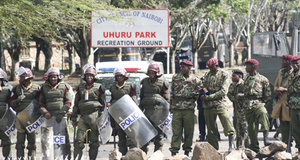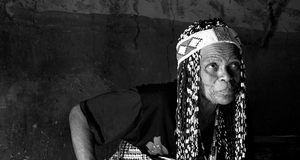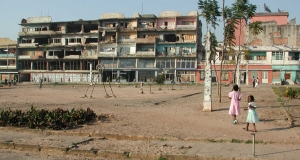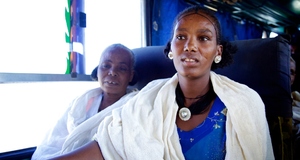From the FieldBoda Boda: The Impact of Motorbike Taxi Service in Rural Uganda2. Geography and Economy2.1 Ugandan Geography and EconomyUganda, located in sub Saharan Africa and landlocked, lays on a plateau with a minimum altitude of 2000 ft. and peaks of 16794 ft. for the Ruwenzori Mountain in the South East and 14176 ft. at the Elgon Mountain at the extreme West of the country. The complex orography is characterized by the presence of numerous lakes and waterfalls that determine the natural environment and human settlements. The fog forest, typical of highlands in tropical areas, that are cooler and often characterized by warm mist produced by hot and humid winds that blow on the slopes favoring fog condensation, is predominant. Observations show the highest of rainfalls is in October-November and April-May. Uganda is a Democratic Republic with a Presidential form of Government. The country has 36.35 million inhabitants with a GDP of 19.8 billion USD and economically, with the discovery of major oil fields has recently entered into the club of African oil producing countries. This discovery might become the main engine of development to make the former British colony an emerging country, with the danger of an asymmetric development and increasing social and economic inequalities. The start of the oil production is, however, scheduled for 2016 and the country’s economy is currently recording, due to international economic downturns, decline in domestic demand and a weak increase in industrial and tertiary sectors, a significant slowdown. The current situation is therefore likely to compromise the projected growth of 7% for 2013. "In this situation a more realistic data for growth will stabilize at 3.4%," warns Lawrence Othieno, director of the Center for Economic Research and Policy at the University of Makerere. The Ugandan economy, however, is still largely based on agriculture and commercialization of produce which contributes to more than a quarter of the GDP and employs about 85% of the working population.2.2 Kabale Geography and EconomyKabale district is located in the southwest of the country, has a temperate foggy climate, which is typical of an equatorial region at significant heights. The district’s altitude has an average altitude of 6000 ft. and reaches its top at the 8360 ft. of the Bafunda Hills. The daily average monthly temperature in the district is about 18 ° C (64 ° F) and can drop to 10 ° C (50 ° F) at night, while the maximum rainfall is between April / May and October / November. This climate permits two sowings and two harvests per year without the need for irrigation by farmers. This area mainly cultivates Irish potatoes, sorghum, maize, and sweet potatoes which are the staple foods of the population. Other agricultural produce include cassava, beans, peas, ground nuts, onions, tomatoes and pineapples. The territory, very hilly and green is characterized also by the presence of many lakes and national parks (Bwindi Impenetrable Park and Mgahinga Gorilla Park), only allows a scattered human settlements dispersed along the valleys and the highlands with the presence of only one urban center, the district capital of Kabale. The population of the district amounted to 498,300 people, of which 44,000 living in the capital Kabale (UBOS 2013). The rural population is then estimated to be 88.3%, and it is remarkable noticing how the proportion of people living outside the urban area has remained constant for the last two decades. 2.3 Villages and Subsistence AgricultureThe country's agricultural production is characterized by the gap between plantations operated by multinational corporation and that of subsistence. The former are focused on monoculture production of cash crops such as coffee sugar and tobacco. While also providing foreign exchange and accounting for 27.1% of the entire country’s export activities (World Bank), it also creates a country's dependence on foreign markets (especially for coffee), which is reflected on prices and employment in agriculture. The latter practice, of subsistence agriculture, is characterized by individual farmers (at earlier points in time referred to as “peasants”) working to support themselves through the cultivation of different crops on a relatively small plot of land. In Kabale district, which is the main country’s producer of sweet potatoes and Irish potatoes (UBOS 2013) most of the farmers fall into the subsistence category; the area also produces sorghum, beans, and cassava. The district is also. This type of subsistence agriculture suffers from considerable fragmentation of the private land and puts individuals at risk of all sorts of shocks, including environmental ones such droughts or excess rains. The plots are still cultivated with very basic technology such as hoe and a plow, fertilizers is infrequently used, and overall productivity is low. 2.4 Welfare in Kabale DistrictThe presence of a medium size urban center as Kabale, equipped with health and educational infrastructures, has been proven insufficient to guarantee, by itself, the district population access to those services needed to increase their level of welfare. This is because 88% of the population lives in villages that are structured on individual homes, isolated from each other, and scattered in the highlands. The Ugandan Government officially guarantees all people living in rural areas access to the education and health infrastructure, but the quality of the services is generally low, and the local administrations do not offer transportation means for people living far from these services empting such a promise of any real meaning. Location of where one resides is important when it comes to accessing these services, especially in the western mountainous part of the country where there is a literacy gap of around 20% between the rural and urban population (UBOS 2013). These data highlight the difficulties in pursuing the objectives of Millennium Development Goals in rural areas. These communities should therefore become increasingly connected and integrated with each other and with the urban center, to enable its residents to pursue the goal of improving their own personal well-being. 3. Transportation3.1 Ugandan Transportation NetworkUganda has a road network infrastructure, which, although in line with other countries in the same region (Raballand et. all 2009, p.16), is insufficient to accomplish the Ugandan government’s goal of the economic and social integration of all citizens (National Development Plan). The rail transport system is still one of the major problems of the country. The railway network, managed by the Consortium Rift Valley Railways (RVR), is the shortest of the African continent, with its 337 km (National Development Plan). The network is in a state of severe dysfunction and scarce profitability, and only functions as a freight link between Kampala and the port of Mombasa in Kenya; there is no service for private citizens, within the Ugandan border, who are consequently obliged to rely on road mobility. The Uganda National Development Plan provides a description of the road network in Uganda which is 78,000 Km long. It is comprised of national roads connecting the major cities for a length of 10,800 km of which 2,870 are covered with standard asphalt and 7,930 km are gravel surfaced. The network also counts the district roads that are primarily gravel or packed dirt which amount to 27,000 Km. It is estimated that 55% of these roads are currently in mediocre or poor conditions (Raballand et. all 2009, p.16). The remaining 36,000 km of roads are defined as community access roads which are paths that link communities to social and trade centers. The condition of these dirt roads is generally poor; they are season roads, generally not usable by trucks, and only open to cars during dry seasons. 3.2 Transportation Network in South West UgandaIn the poor road infrastructure context offered by the country, the demand for mobility of the rural population living in the mountainous areas of the south western Uganda is problematic to satisfy. This population has a higher poverty level compared to that living in the city. Subsequently, they have an even greater need than the urban dwellers to move in order to have access to the network of opportunities in the region. The lack of infrastructure forces the majority of this rural population to utilize systems of mobility particularly suited for the geographic features of the area, which are substantially different from the services offered on asphalted roads. As revealed recently, the transportation system in the area suffers, as in many other Sub-Saharan regions, of the “missing middle,” a mobility instrument suitable for the geographic and socio economic features of the area. Empirical observation shows that in the South West Ugandan rural areas, movement of people “…goes from walking…to truck and bus in one technological leap.” (Howe 2003, p.161). Cars, due to the extremely high operative costs (a liter of fuel costs 3750 Ugandan Shillings which is equal to $ 5.55 per gallon) are generally out of reach of the population, while trucks and buses, although more affordable cannot reach every community. The system of private taxi service called Boda Boda performed with bikes and motorbikes which is a peculiarity of the region is, nowadays, the most used in the villages of the highlands. The two wheel vehicles can indeed overcome the roughness of the community access roads and provide a relatively affordable transportation system for the remote populations. 3.3 History of Boda BodaAt the beginning of the 1960s, Ugandan smugglers needed a cheap, reliable, and quiet way to move materials between Uganda and Kenya. Cars were too expensive and noisy, and so were motorbikes. Their choice was to use bicycles which, with a little luggage rack behind the seat, were perfect for evading the border police while transporting valuable goods. The idea had an unexpected development. Those bikes were so strong that perhaps were also suitable as taxis to transport people. The gains were lower than those derived from smuggling, but at least the business was legal and the riders did not have to deal with the police system of the two countries. This development gave rise to the Boda Boda taxi system which, from the border between Uganda and Kenya, where it was invented spread quickly in east Africa. The name still carries its outlaw’s origins and it is a mispronunciation of the words “border border,” which just reminds the smuggling practices of the 1960s. Today it has become a common means of transportation especially in rural areas of Southeast Asia and Central Africa. The motorcycle Boda Boda, more robust and with a better ability to go longer distances and climb up hill compared to the bicycle, first appeared on the Ugandan market in 1992, and had a rapid growth due to the Government easing on the restrictions on import of vehicles more than 5 years old (Howe 2003, p.163). The cheapness of the imported used motorcycles, compared to the cost of cars caused the fleet growth, and the success of the phenomenon. The Boda Boda motorcycle taxi system has become a fairly reliable, rapid and relatively cheap service which can pass on dirt roads that are too difficult for car and go longer distances and into steeper terrain that would be possible with a bicycle. Functionally, Boda Boda are used for kids and teachers to go to school, workers and employees to go to work and, in the villages, it facilitates travel to markets and health facilities. The motorcycle taxi driver, however, is not an easy job and it is currently only the work of young men. Every day they travel around 50 Km, and this factor, together with accidents and the dust they inhale, leads to illnesses and weakness. A further indication that the Boda Boda job is dangerous comes from the local press which, citing police reports, states that between 2008 and 2012 the injuries among drivers increased from 1795 to 3043 (SSenkaaba). 3.4 Organization and Regulation of Boda BodaIt is not difficult to become a Boda Boda motorcycle operator. The only requirement is to buy or rent a bike, and pay an annual fee to the local Boda Boda association. The cost for a used motorcycle is about 3 million Ugandan shillings (about $ 1,200). The drivers are required to belong to Boda Boda associations which are an administrative tool created by the Ugandan Government to regulate the industry. The annual membership fee ranges between $6 and $10 and comprises of the municipal operating license (plate) and the actual association membership subscription. The associations act as an insurance agent and legally represent the drivers in case of accidents. In the following pages I show the results of a study performed in December 2013 that investigates the socio-economic impact of the Boda Boda services on the agricultural population welfare of two villages in Kabale district.Continued on Next Page » Suggested Reading from Inquiries Journal
Inquiries Journal provides undergraduate and graduate students around the world a platform for the wide dissemination of academic work over a range of core disciplines. Representing the work of students from hundreds of institutions around the globe, Inquiries Journal's large database of academic articles is completely free. Learn more | Blog | Submit Latest in Economics |


















